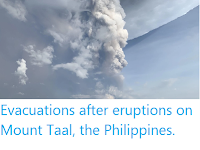The Philippine Institute of Volcanology and Seismology has raised the alert level on Mount Kanlaon, a 2465 m stratovolcano (cone shaped volcano made up of
layers of ash and lava) on northern Negros Island in the central
Philippines, following a series of seismic events thought likely to have been caused by phreatic eruptions (explosions caused by magma or other hot volcanic material coming into contact with water) within the volcano's crater. People are being 'strongly advised' not to go withing four kilometres of the volcano, due to the possibility of an imminent eruption; planes are also being advised to keep clear of the area.
Mount Kanloan on northern Negros Island, the Philippines. Wikimedia Commons.
The
geology of the Philippines is complex, with the majority of the islands
located on the east of the Sunda Plate. To the east of this lies the
Philippine Sea plate, which is being subducted beneath the Sunda Plate
(a breakaway part of the Eurasian Plate); further east, in the Mariana
Islands, the Pacific Plate is being subducted beneath the Philippine Sea
Plate. This is not a smooth process, and the rocks of the tectonic
plates frequently stick together before eventually being broken apart by
the rising pressure, leading to Earthquakes in the process. Material
from the subducting Philippine Plate is heated by the temperature of the
Earth's interior, causing lighter minerals to melt and the resultant
magma to rise through the overlying Sunda Plate, fuelling the volcanoes
of the Philippines.
Subduction beneath the Philippines. Yves Descatoire/Singapore Earth Observatory.
See also...
Follow Sciency Thoughts on
Facebook.








